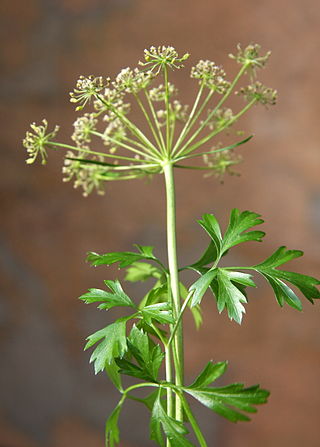
Parsley, or garden parsley is a species of flowering plant in the family Apiaceae that is native to Greece, Morocco and the former Yugoslavia. It has been introduced and naturalized in Europe and elsewhere in the world with suitable climates, and is widely cultivated as an herb and a vegetable.

The Willamette River is a major tributary of the Columbia River, accounting for 12 to 15 percent of the Columbia's flow. The Willamette's main stem is 187 miles (301 km) long, lying entirely in northwestern Oregon in the United States. Flowing northward between the Oregon Coast Range and the Cascade Range, the river and its tributaries form the Willamette Valley, a basin that contains two-thirds of Oregon's population, including the state capital, Salem, and the state's largest city, Portland, which surrounds the Willamette's mouth at the Columbia.
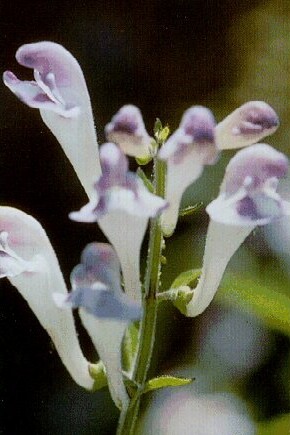
Scutellaria montana, with the common names largeflower skullcap, large-flowered skullcap and mountain skullcap, is a perennial forb first described by Alvan Chapman in 1878. This narrowly endemic species is found in the southeastern United States in parts of the Ridge and Valley and Cumberland Plateau Physiographic Provinces. Populations have been documented from four Tennessee counties and nine Georgia counties and is protected under the US Endangered Species act as it is a threatened species. The Latin specific epithet montana refers to mountains or coming from mountains.

Lomatium is a genus in the family Apiaceae. It consists of about 100 species. Its common names include biscuitroot, Indian parsley, and desert parsley. It is in the family Apiaceae and therefore related to many familiar edible species such as carrots and celery. Native to western Northern America and northern Mexico, some Lomatium species are extensively used by Native Americans in the inland Pacific Northwest as a staple food.

The Santa Cruz cypress is a species of North American tree within the cypress family. The species is endemic to the Santa Cruz Mountains within the Santa Cruz and San Mateo counties of west-central California. The U.S. Fish and Wildlife Service listed the species on the Endangered Species Act in 1987 due to increasing threats from habitat loss and disruption of natural forest fire regimes. In 2016, the conservation status of the Santa Cruz cypress changed to Threatened. The cited reasoning was a decrease in threats against their habitat.

William L. Finley National Wildlife Refuge is a natural area in the Willamette Valley in Oregon, United States. It was created to provide wintering habitat for dusky Canada geese. Unlike other Canada geese, dusky Canada geese have limited summer and winter ranges. They nest on Alaska's Copper River Delta and winter almost exclusively in the Willamette Valley. Habitat loss, predation, and hunting have caused a decrease in population.
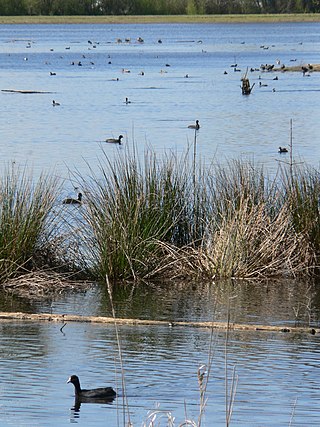
Ankeny National Wildlife Refuge is located in the fertile Willamette Valley of northwestern Oregon, 12 miles (19 km) south of Salem. The valley was once a rich mix of wildlife habitats. Valley wetlands were once extensive, with meandering stream channels and vast seasonal marshes. Today, the valley is a mix of farmland and growing cities, with few areas remaining for wildlife.
The Agate Desert is a prairie located near White City, Oregon, 53 acres (21 ha) of which is protected as the Agate Desert Preserve. The area is not in fact a desert as its name suggests; it is so named because of the abundance of agate, petrified wood, jasper, and other minerals found there. Much of the World War II army training base of Camp White was built in the Agate Desert. The Nature Conservancy is working to preserve the Agate Desert as a native Rogue River Valley grassland.

Baskett Slough National Wildlife Refuge is in northwestern Oregon, 10 miles (16 km) west of Salem in Polk County. The Refuge consists of 1,173 acres (4.75 km2) of cropland, which provide forage for wintering geese, 300 acres (1.2 km2) of forests, 550 acres (2.2 km2) of grasslands, and 500 acres (2.0 km2) of shallow water seasonal wetlands and 35 acres (0.14 km2) of permanent open water. In 1965, Baskett Slough National Wildlife Refuge was created to help ensure some of the original habitat remained for species preservation. The refuge is managed by the U.S. Fish and Wildlife Service, an agency of the U.S. Department of the Interior.
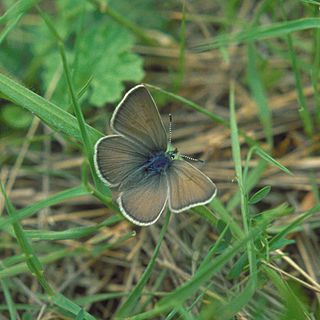
Fender's blue butterfly is a subspecies of Boisduval's blue endemic to the Willamette Valley of northwestern Oregon, United States. The potential range of the butterfly extends from south and west of Portland, OR to south of Eugene, OR. The butterfly is host-specific on the Kincaid's lupine, which it relies on for reproduction and growth. The male and female can be identified by their difference in wing color. The Fender's Blue Butterfly was added to the endangered species list in January 2000, but as of February of 2023, has been reclassified as "threatened". The Fender's blue butterfly population has increased over the past 20 years and projected to increase more through conservation efforts. In Willamette Valley, Oregon, there are currently 90 sites filled with Fender's blue.
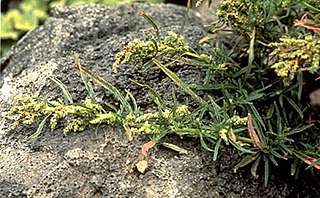
Amaranthus brownii was an annual herb in the family Amaranthaceae. The plant was found only on the small island of Nihoa in the Northwestern Hawaiian Islands, growing on rocky outcrops at altitudes of 120–215 m (394–705 ft). It was one of nine species of Amaranthus in the Hawaiian Islands, as well as the only endemic Hawaiian species of the genus. It is now considered extinct.

The Kauaʻi cave wolf spider, also known to local residents as the blind spider, is only known to occur in a few caves in a lava flow with an area of 10.5 km2 (4.1 sq mi) in the Kōloa–Poʻipū region of Kauaʻi, Hawaiian Islands, and only six populations are known to exist. While their nearest surface-dwelling relatives have large eyes, this species has completely lost its eyes. They reach a body length around 20 mm (0.8 in), and are reddish brown and completely harmless to people. Unlike most wolf spiders, it produces only 15 to 30 eggs per clutch. The female carries the egg sac in her mouthparts until the spiderlings hatch.
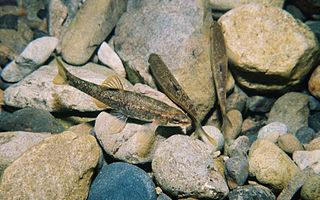
The speckled dace, also known as the spotted dace and the carpita pinta, is a member of the minnow family. It is found in temperate freshwater in North America, from Sonora, Mexico, to British Columbia, Canada.

Eremogone ursina is a species of flowering plant in the family Caryophyllaceae known by the common name Bear Valley sandwort.

Lomatium grayi, commonly known as Gray's biscuitroot, Gray's desert parsley, or pungent desert parsley, is a perennial herb of the family Apiaceae. It is native to Western Canada in British Columbia, and the Western United States, including from the Eastern Cascades and northeastern California to the Rocky Mountains.

Acmispon dendroideus, synonym Syrmatium veatchii, is a species of legume native to California. It is known by the common name island broom. It is endemic to the Channel Islands of California, where it grows on coastal bluffs and cliffs. It is a spreading perennial herb or erect shrub approaching 2 meters in height. It is hairless to hairy and gray-green in color. The branches lined with leaves each made up of a few oval leaflike leaflets up to 1.5 centimeters long each. The inflorescence bears up to 10 yellow pealike flowers, each roughly a centimeter long and fading red as they age.

Castilleja levisecta is a rare species of flowering plant in the family Orobanchaceae known by the common name golden paintbrush, or golden Indian paintbrush, listed under the Endangered Species Act in 1997. It is native to British Columbia and Washington, where it is known from eleven remaining populations. It occurred in Oregon but all natural occurrences there have been extirpated. It has been reintroduced to a few areas in Oregon, but it remains to be seen if the plants will survive. The plant is a federally listed endangered species of Canada and was listed as threatened in the United States in 1997. On June 30, 2021, the plant was proposed for delisting due to recovery. Effective August 18, 2023, the U.S. Fish and Wildlife Service issued a rule removing golden paintbrush from the Federal List of Endangered and Threatened Plants
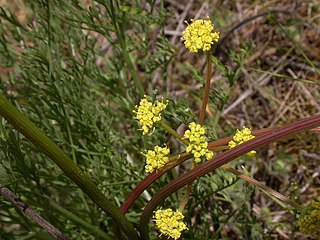
Lomatium cookii is a rare species of flowering plant in the carrot family known by the common names Cook's lomatium and agate desertparsley. It is endemic to Oregon in the United States, where it grows in only two valleys. It is a federally listed endangered species.

Sidalcea nelsoniana is a rare species of flowering plant in the mallow family known by the common names Nelson's checkerbloom and Nelson's checkermallow. It is native to the Willamette Valley and Coast Range of Oregon and the southwestern corner of Washington in the United States. It is threatened by the destruction and degradation of its habitat, and it is a federally listed threatened species of the United States.

Lomatium orientale, commonly known as salt-and-pepper, eastern cous, eastern desert-parsley, eastern lomatium, white-flowered desert-parsley, oriental desert parsley or Northern Idaho biscuitroot, is a small spring blooming ephemeral plant. It grows in open habitats from the plains to foothills in western North America. It is known as one of the earliest blooming native flowers in its habitat. The species name, "orientale", is botanical Latin meaning "eastern".



















